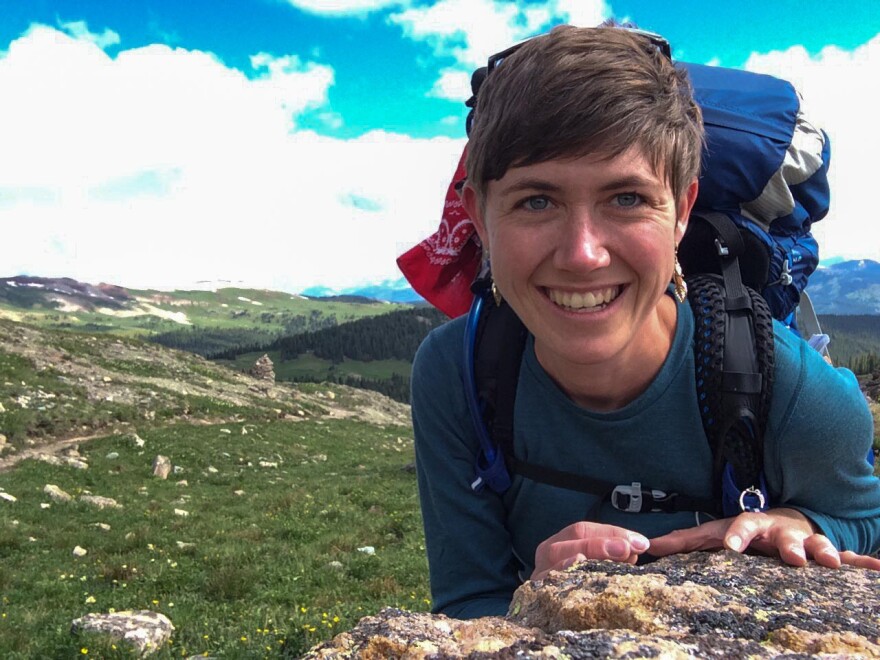Former Wyoming Public Radio reporter and host Willow Belden left her job this spring to hike the Colorado Trail. That’s a 500-mile path through the Rockies, from Denver to Durango. She did the journey alone.
The Colorado Trail crosses eight mountain ranges, and climbs nearly three times the height of Mount Everest. It’s mostly above 10,000 feet, so the air is thin, there’s significant danger of lightning strikes, and it often freezes at night. About 400 people attempt the trail each year, but only 150 make it to Durango.
I was not remotely qualified to hike a trail like that. The longest I’d backpacked was two nights, and I’d never gone solo. I also had a fear of heights. Embarking on a 500-mile trek, by myself, through some of the most remote corners of the Rockies, was a big risk.
My first day out, after hiking in the hot sun all morning, I arrived at a small stream. I had planned to camp here, but it was only noon, and that seemed too early to stop for the day.

I had a problem, though. The next water source was eight miles away, and I knew I wouldn’t make it that far. I’d have to dry camp, and I’d probably run out of water. I’d be thirsty, and – crucially - there would be no coffee in the morning. I also wouldn’t be able to rinse the sweat and grime off myself before crawling into my sleeping bag.
I thought about how much easier it would be to just camp where I was, by the stream. But I didn’t know what I’d do all afternoon, if not hike. So I filled my water bottles, picked up my pack and continued down the trail.
I ended up camping on a beautiful ridge, overlooking a river canyon. I set up my tent in the shelter of some bushes and ate dinner on a rocky promontory, watching a brilliant red sunset. This campsite was far nicer than the weedy banks of the creek. And dry camping wasn’t so bad. As it turned out, I’d carried plenty of water for drinking and coffee. I had made the right decision.
That night, I thought about the bigger risk I had taken in starting the trail: I gave up my job to do the hike. It was a good job, at a good radio station, with colleagues I liked and respected. I had nothing lined up for afterwards.
This is not the kind of risk I normally would have taken. Since my parents died several years ago, I’d been increasingly risk-averse. I was reluctant to go to dangerous places, or try new things. My mind would make a list of everything that could go wrong, before considering what could go right. At work, I hesitated to take on tough reporting assignments.
Studies show that many of us, especially women, are in the same boat. We fear failure, so we’re unwilling to take risks. We settle for the status quo, even if it’s boring and unsatisfying, because it’s safe.

Before my hike, I was no exception. I kept telling myself that my life was good enough. I had a well-respected and meaningful job, plenty of friends, a caring significant other, and cross-country ski trails 10 minutes from my house. But my life was passionless. I wasn’t sure I’d chosen the right career, and I couldn’t shake a feeling of emotional emptiness. A quote from Henry David Thoreau kept running through my thoughts: “The mass of men lead lives of quiet desperation.”
I knew I needed to get away. And when the idea of a long hike first inched its way into my mind, it instantly felt right – totally, viscerally right.
I was terrified, but also thrilled.
I spent the winter reading books about long-distance hiking, and shopped for gear. I bought a little orange tent, a 10-degree sleeping quilt, a new backpack, and a pair of trekking poles. I made a stove out of an empty catfood can. In the spring, I went for long training hikes at Vedauwoo. And I mailed boxes of Clif Bars and backpacker meals to towns along the trail.
After that first unplanned night on the trail, I tried more and more things that seemed dangerous or scary, and they turned out fine. I did not get eaten by bears. I didn’t get hypothermia. I didn’t get kidnapped or raped when I hitch hiked into towns to resupply. And I didn’t perish attempting to summit a fourteener alone, in the fog.

Taking risks actually made me happier. Pushing myself outside my comfort zone over and over again boosted my confidence, and eventually I stopped agonizing over things that could go wrong. When the trail stayed above tree line for three days straight, I shrugged off the danger of lightning storms and let myself savor the view along the Continental Divide. I was finally living in the moment, rather than worrying about what was ahead. It was exhilarating.
On August 12th, five weeks after I’d set out from Denver, I finished the trail. A quiet sense of accomplishment tingled through my limbs.
The trail had been brutal at times. I’d hiked through heat and cold, dangerously close lightning storms, epic mosquitoes and weeks of monsoon. Blisters had taken over my toes, and several items of gear had broken.
But by the end, I realized I was happier than I’d been in a long time.

Two days after I returned home, I realized suddenly what I wanted next in life. I felt a glorious sense of excitement and optimism. After years of lethargy, I’d figured out what my dreams were, and I’d gained the energy and confidence to follow them. Fear had given way to ambition. I felt strong, invigorated and whole. I was ready to take chances, knowing I might fail. And for the first time in years, I felt like I was truly living.


